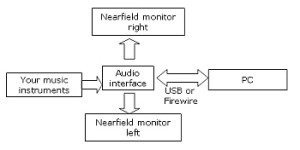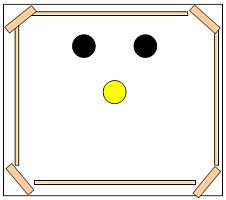Do you plan to seriously record and produce music at home? Seems like a broad plan but below are the details. This is the best way of recording music at home that can provide the best quality for any type projects.
Fast and Reliable Computer for Recording
First but the most important thing that you need is a very powerful personal computer. You should read this information to know the desirable factors in assembling your computer for audio recording.
In summary below are the most important checklists:
a.) Use the latest motherboard if you can. Motherboard tends to support the fastest processor, USB and Firewire connection speeds which are crucial for recording performance.
b.) Use the fastest processor supported by your motherboard.
c.) Modern motherboards support high capacity RAM. If you are using Windows 32-bit operating system, then use a maximum of 4GB. If you have a 64-bit operating system, you can use more than 4GB of RAM.
d.) You should not worry about selecting 32-bit and 64-bit operating systems. Personally I’ve been using 32-bit operating system and have no issues using it.
64-bit operating systems seem to be faster and more responsive because of bigger memory capacity. One downside is that this tends to be more expensive to maintain.
e.) If you are using Mac, then use the specs designed for audio recording. Most modern Mac does support this.
Get a professional audio interface
Second, do not forget to buy an audio interface. This is NOT your ordinary on-board soundcard or PCI soundcards in your motherboard.
Audio interface hardware used for music production is usually external USB or Firewire audio interface. External USB audio interface can be hook up to your computer via the USB port. Firewire audio interface requires that your computer motherboard has a Firewire port. Below is a picture of a Saffire Pro 40 Firewire audio interface:
Whether you choose USB or Firewire, it all depends on what is supported by your motherboard. If it doesn’t have a Firewire port; then you should be using an external USB audio interface.
Read the following related tutorials pertaining to buying either a Firewire or USB audio interface:
Selecting between USB & Firewire audio interface
List of 24bit/96KHz audio interface for Windows
Optimizing your OS for Firewire and USB audio interface
Guide in buying audio interface for beginners
Once you have those pieces of gears in your home music studio, you do not need any more to buy an audio mixer. It is because audio interface already contains the following most important features for recording that makes it unnecessary to buy a mixer:
a.) High quality microphone preamp with gain adjustment.
b.) Mixer panel (audio interface contains a software mixer equivalent to a hardware audio mixing features).
c.) Balanced inputs and outputs for connecting your musical instruments and nearfield/studio monitors.
Get DAW Software and configure your system
Digital audio workstation is your main recording, mixing and mastering software. The most recommended is REAPER because of a very affordable licensing and its complete DAW software. You can read my full review here to get more information about this digital audio workstation.
For most home recording studio setups, REAPER does fit the job very well. The standard procedures for setting up your digital recording system (assuming you already have the DAW/recording software and audio interface):
Step1.) Install your audio interface drivers first. Make sure you are installing the most updated drivers. You can get them from the manufacturer website.
Most manufacturers of audio interface recommends that you will only connect your audio interface hardware to your computer (whether USB or Firewire) only after completing the driver installation.
Step2.) Connect your audio interface drivers and do some playback testing.
Step3.) Once you are sure that your audio interface is working, install your DAW software.
Step4.) Configure your DAW to record and play from your audio interface.
Step5.) Once setup is complete, do a test recording.
If you want an example, you can read the following tutorials on setting up Saffire Pro 40 audio interface using REAPER digital audio workstation software:
Installation of REAPER and activating license
Connect everything as follows:
Microphones and other recording gears
Microphones are very important gears in recording studio. It can be used to record all musical instruments you can think of (vocals, guitars, amplifier cabinets, etc.). Read this useful post on selecting a microphone for home recording. You can find some microphone recommendations for vocals, drums, guitars, etc.
Make sure that you are connecting all instruments (including microphones) to your audio interface using balanced connections. With this setup; there will be no noise on your recordings. Read this very useful guide to learn why this is the case.
You should also have your own instruments like guitars, keyboards, cables, guitar amplifiers, effects, etc. Then try to purchase a microphone stand. It is very helpful for vocals.
Treat your room with acoustic materials
First, position your nearfield monitors for accuracy. I recommend below (this is top view):


